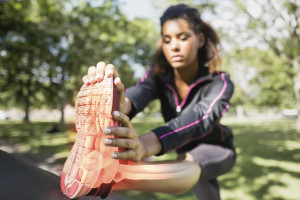
The sunny days of summer are long gone, which means it’s time for all of us to start taking our vitamin D supplements.
Vitamin D is a necessary and crucial component of bone health. Unfortunately, we often don’t think about bone health until it is too late and the damage is done.
Osteoporosis, a condition in which the bones become brittle and fragile from loss of tissue, is often a silent disease. By the time a fracture occurs, there are usually several other bones already affected.
The good news is that osteoporosis can be prevented. And, if your bones are already weak, there are ways to keep more loss from happening and strategies to keep fractures to a minimum.
Bone mass reaches a peak
Our bones are constantly turning over and renewing. In fact, there are cells that build new bone and others that break it down to make way for new bone.
Our bone mass level and fracture risk depend on the rate of new bone growth compared to the rate of breakdown.
Most women reach a peak bone mass at age 32 and lose a small amount of bone mass every year. In the first five years of menopause, if a woman does not take estrogen, her bone loss will accelerate, increasing her risk for issues such as osteoporosis.
If we aren’t active enough, our builder cells don’t think they are needed and won’t make new bone. Osteoporosis can result, making our bones weak enough to increase the risk for a fracture from minimal trauma—like stepping off a curb awkwardly or a minor fall.
We also need to be aware of a similar but less severe disease than osteoporosis: Osteopenia can occur when the bones are thinner than they should be at a given age.
Osteoporosis has a staggering effect on women’s health.
The most common fractures occur in the hip, but can also occur in the wrist and upper leg bone, with a possibility of micro fractures in the spinal bones.
You may be surprised to learn that another, less well-known complication of osteoporosis is the loss or cracking of teeth and poor healing after dental procedures.
Unfortunately, the effects of osteoporosis impacts our lives in many different ways. There may be surgeries to repair fractures, time off work and physical therapy. Complications from surgery may also occur, including weight gain, muscle weakening, infection, pneumonia and even stroke. Chronic pain can become an issue as well, especially for spinal bone fractures.
The risk factors of osteoporosis are numerous, but the most common are aging, vitamin D deficiency, inactivity, oral steroid intake, cigarette smoking and poor calcium intake.
For women who are underweight, they are at risk of rapid bone loss due to not having enough stress on their bones. There are many other, less common risk factors, including the following: medical issues such as eating disorders and poor nutrition, excessive consumption of carbonated sodas, and poor absorption of nutrients due to colon problems (prior gastric bypass or Celiac disease).
A family history of osteoporosis, rheumatoid arthritis, early menopause due to surgery or chemotherapy, or lupus can also increase a woman’s risk of developing osteoporosis.
Options and opportunities
I had a patient I’ll call Sue several years ago who was diagnosed with osteoporosis. I saw Sue in my office just after she started menopause.
As I always do with my menopause patients, I asked about her risk factors for accelerated bone loss. Sue was at a healthy weight but only exercised occasionally. She didn’t have any medical risk factors and had never had a fracture before, but she had also never taken a vitamin D supplement. Because Sue was in menopause and had never taken vitamin D, I ordered a DEXA scan—an enhanced form of X-ray technology that is used to measure bone loss.
When I called Sue with the results of her DEXA scan, she was not pleased. Her results showed that she had osteoporosis, and she had a greater than 20 percent risk for an osteoporotic fracture in the next 10 years. She also had a greater than 35 percent risk of a hip fracture during the same time period.
Sue’s reaction was very typical of many others when they are told they have osteoporosis. She was angry at herself, but she was also angry at the medical community because, at that time, we were not yet routinely recommending vitamin D supplementation.
She had always been told to wear sunscreen, which she did, whenever she went outside. And now she was being told a lack of vitamin D possibly contributed to her osteoporosis diagnosis? It just didn’t seem fair.
Once Sue’s anger subsided, we discussed what she should do next. I tested her for thyroid disease, vitamin D deficiency and parathyroid disease. Since Sue was in menopause, we discussed estrogen patches and pills that are FDA-approved for the prevention of osteoporosis. Sue chose not to take estrogen, but she was open to other options.
Although the tests showed Sue’s vitamin D level was very low, her other tests were normal—good news! So, we came up with a plan to keep Sue’s bones as healthy as possible.
I explained that the most important factors for keeping bones strong and preventing fractures is to eat a healthy diet and exercise regularly. I recommended Sue start on a prescription vitamin D tablet of 50,000 IU per week for two months and then 2,000 IU per day after that. I also suggested calcium-rich foods such as dairy products, almond or soy milk, and dark, leafy greens.
For exercise, we created a routine that included walking, jogging, Zumba classes and weight lifting. On days when Sue simply couldn’t fit in a workout, I advised her to jump up and down 50 times as a way to remind her bones to stay healthy.
In addition to diet and exercise, we discussed a few different prescription drugs, such as Raloxifene or Bisphoshonates, that help treat and prevent osteoporosis. Fortunately the Spectrum Health Medical Group has a Bone Care & Osteoporosis Center. She chose to be referred to this group to further discuss her options, and to better understand the pros and cons of the various medications.
In the end, Sue chose to look at the situation as a gift. She strove to maintain the bones she already had and make them as strong as possible.
 /a>
/a>
 /a>
/a>
 /a>
/a>
My wife has osteoporosis and is taking calcium and vitamin D as recommended by her dr. I just read of a study that shows vitamin D is not helpful unless one’s Vitamin D is very low. It also stated that calcium and vitamin D can lead to cardiac problems and that calcium alone could cause cardiac problems. These findings seem inconsistent with the above story.
Hi Earl – Thank you for being a Health Beat reader, and for your question and concern for your wife’s well-being. We recommend she chat with her physician about any concerns she has about her treatment or nutritional supplements. Unfortunately, there is not a one-size-fits-all study out there on this matter. Best wishes to you both. Cheers, Cheryl